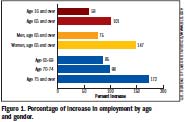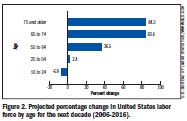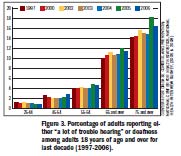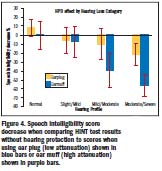Personalize Hearing Conservation for Hearing-Impaired Workers
While some impairment might be due to aging, if occupational noise contributed to the hearing loss, the loss is considered work-related.
- By Theresa Y. Schulz
- Jun 01, 2009
Workers often don't file for hearing loss compensation until they retire. But with workers staying in the workforce longer, will the compensation bill eventually be larger? There are ways to prevent noise-induced hearing loss (NIHL), even for those workers who may already have some level of hearing impairment.
More and more American workers remain in or are returning to the workforce as they pass the traditional "retirement age." This trend has been going on for a few years. Based on data from the U.S. Bureau of Labor Statistics (BLS), workers past the age of 75 are largely responsible for the increase in older workers over the last three decades. In 2007, 5.8 million (16.0 percent) Americans age 65 and older were working or actively seeking work and constituted 3.8 percent of the U.S. labor force (Figure 1).
Returning to work or delaying retirement may become more common due to the current eco nomic situation. In fact, projections by BLS predict a significant increase in older workers overall in the next decade (Figure 2).
nomic situation. In fact, projections by BLS predict a significant increase in older workers overall in the next decade (Figure 2).
While many may expect an older workforce to hinder efficiencies in productivity, a recent study by the PMA Insurance Group proves the opposite. The report says, "Not surprisingly, as people age, their skills and faculties, including strength, range of motion, motor skills, sensory acuity and ability to heal diminish. While this may suggest that older workers would have a negative effect on workplace productivity and safety, statistics prove otherwise."2
In fact, the PMA study reports that as workers older than age 55 increase in the workplace, so do productivity and overall workplace safety. However, when older workers do experience injuries, severity can be significant, which is an issue that must be considered by safety professionals.
These findings lead to two conclusions, according to the paper. One, older workers are a benefit to the company that employs them; and two, it pays to make modifications to work environments to prevent injuries and limit the severity of injuries commonly sustained by older workers. This seems to be especially good advice in regards to noise-induced hearing loss.
Visual and hearing impairment rise sharply with age, according to a study by the National Center for Health Statistics. This survey asked non-institutionalized adults questions about their health. Figure 3  demonstrates that workers older than 75 (whose numbers are increasing dramatically) are four times more likely to have a significant hearing impairment than workers in the 55-64 age group. And the trend since 1997 shows more of those older Americans reporting significant hearing loss, suggesting at least some of the additional older workers that are projected by BLS are likely to have some degree of hearing impairment. While some of the hearing impairment might be due to presbycusis (hearing loss due to aging), if occupational noise contributed to the hearing loss, the hearing loss is considered work-related.
demonstrates that workers older than 75 (whose numbers are increasing dramatically) are four times more likely to have a significant hearing impairment than workers in the 55-64 age group. And the trend since 1997 shows more of those older Americans reporting significant hearing loss, suggesting at least some of the additional older workers that are projected by BLS are likely to have some degree of hearing impairment. While some of the hearing impairment might be due to presbycusis (hearing loss due to aging), if occupational noise contributed to the hearing loss, the hearing loss is considered work-related.
However, it is not just older workers who report hearing impairment. In some cases, we've created our own hearing-impaired workers due to less-thaneffective Hearing Conservation Programs.
Concerns for the Hearing-Impaired Worker
Recent research by Morata, et al. at NIOSH in 2005 shows that those hearing-impaired workers have some unique concerns, as well as sharing common concerns about health and safety with their normal-hearing colleagues. The Morata, et al. study found that hearing-impaired workers, supervisors of hearing-impaired workers, and Hearing Conservation Program managers identifi ed the following concerns about working in noise with a hearing loss:
- Job performance
- Impact on job safety
- Impaired ability to hear warning signals
- Impaired ability to monitor equipment
- Interference with communication
- Stress and/or fatigue
- Impaired communication caused by hearing protectors
- Reduced ability to monitor environment as a result of hearing protector use
- Concerns about future quality of life
- Concerns about future employability
A surprising finding of the study was that Hearing Conservation Program managers may need more training than line supervisors regarding the special needs of hearing-impaired workers.
Managing Sound and Information Detaille, et al. (2003) looked at what employees with chronic illnesses such as hearing loss say they need to cope at work. The hearing-impaired employees in their study prioritized what they needed to cope in these general categories:
1. Knowledge of hearing aids and ways to finance them
2. Communication strategies
3. Ability to cope with the hearing loss
4. Support of medical professionals and management
5. Accessibility of assistance for better hearing (devices, education, support)
6. Support from colleagues
7. Acceptance of society
8. Adaptations (accommodations) in the workplace
Although the Detaille, et al. study did not focus on noise-hazardous work environments, the information is applicable.
Many noise-exposed workers want as much noise-blocking attenuation as they can get. But with too much attenuation, workers may miss important signals and communication such as verbal communication with co-workers and equipment sounds. This is especially critical for hearing-impaired workers. Many now value their sense of hearing and want to make sure they don't lose more hearing. It's hard to convince workers that overprotection can be harmful, as well. A NIOSH study showed workers who had "adequate" attenuation often returned asking for different hearing protectors with more attenuation. It is a common misconception that more is better!
In a study by Laroche, et al., presented in 2009, researchers used the Hearing In Noise Test (HINT) to measure speech intelligibility with and without hearing protection. As expected, they found that the worse the hearing loss, the poorer the speech intelligibility scores. But that fact was magnified when mildly attenuating ear plugs (average attenuation approximately 13 dBA) were used, and scores were significantly worse when ear muffs with high attenuation (average attenuation approximately 29 dBA) were used. Figure 4 shows that hearing-impaired workers have far poorer speech intelligibility when they have hearing protection that provides too much attenuation.
Personal Strategies for the Hearing-Impaired Worker
The problem is that there is no one single solution for all hearing-impaired workers. Each case must be managed with personal attention to the needs of that worker. There are many factors that are different for each worker. Those factors include:
- Degree of hearing impairment
- Type of hearing loss
- Job tasks
- Noise level
- Work environment
- Communication needs
- Motivation to protect hearing.
This article originally appeared in the June 2009 issue of Occupational Health & Safety.